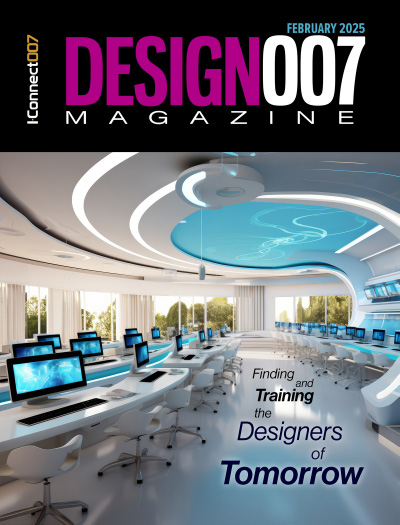-

-
News
News Highlights
- Books
Featured Books
- design007 Magazine
Latest Issues
Current Issue
Learning to Speak ‘Fab’
Our expert contributors clear up many of the miscommunication problems between PCB designers and their fab and assembly stakeholders. As you will see, a little extra planning early in the design cycle can go a long way toward maintaining open lines of communication with the fab and assembly folks.

Training New Designers
Where will we find the next generation of PCB designers and design engineers? Once we locate them, how will we train and educate them? What will PCB designers of the future need to master to deal with tomorrow’s technology?

The Designer of the Future
Our expert contributors peer into their crystal balls and offer their thoughts on the designers and design engineers of tomorrow, and what their jobs will look like.
- Articles
- Columns
Search Console
- Links
- Media kit
||| MENU - design007 Magazine
NASA, Boeing Target New Launch Date for Next Starliner Flight Test
December 11, 2020 | NASAEstimated reading time: 3 minutes
NASA and Boeing now are targeting March 29 for the launch of Starliner’s second uncrewed flight test to the International Space Station as part of the agency’s Commercial Crew Program. Orbital Flight Test-2 (OFT-2) is a critical developmental milestone on the company's path toward flying crew missions for NASA.
For the OFT-2 mission, the CST-100 Starliner spacecraft will launch on a United Launch Alliance Atlas V rocket from Space Launch Complex-41 at Cape Canaveral Air Force Station in Florida, dock to the International Space Station and return to land in the western United States about a week later as part of an end-to-end test to prove the system is ready to fly crew.
“Boeing is making solid progress on the path to flying a second uncrewed test mission and preparing for the company’s Crew Flight Test in 2021,” said Kathy Lueders, associate administrator of NASA’s Human Exploration and Operations Mission Directorate. “Our teams are focused on applying the lessons learned, and it won’t be long until we see Starliner visiting its destination – the International Space Station.”
The OFT-2 Starliner spacecraft is nearing final assembly inside the company’s Commercial Crew and Cargo Processing Facility at NASA’s Kennedy Space Center in Florida. The vehicle’s reusable crew module has been powered up and final checkouts of the avionics, power and propulsion systems are nearing completion. The spacecraft’s parachutes, landing airbags, base heat shield, and its back shells are installed signifying the completion of the vehicle build phase. In the coming weeks, teams will load the crew module with cargo, including Rosie the Rocketeer, and weigh the vehicle before mating it to its service module, which is already complete.
In parallel, Boeing technicians continue to refurbish the crew module flown on Starliner’s first Orbital Flight Test while also building a brand-new service module for NASA’s Boeing Crew Flight Test (CFT), which is now targeting launch in summer 2021, following a successful OFT-2 mission.
NASA astronauts Barry “Butch” Wilmore, Mike Fincke, and Nicole Mann continue to train for CFT, the inaugural crewed flight of the Starliner spacecraft. After the completion of both test flights, NASA astronauts Sunita Williams, Josh Cassada and Jeanette Epps will launch on the Starliner-1 mission, the first of six crew rotation missions NASA and Boeing will fly as part of the agency’s Commercial Crew Program.
Formal qualification of Starliner’s flight software also is underway inside Boeing’s Avionics and Software Integration Lab in Houston. Teams are running both static and dynamic testing of the vehicle’s software to ensure it’s coded as designed and incorporates all mission requirements. Test teams then will perform an entire end-to-end mission scenario, from prelaunch to docking and undocking to landing, using a high-fidelity suite of hardware before flying the OFT-2 mission.
"NASA and Boeing are doing a tremendous amount of work on all aspects of their flight software running numerous cases through the Boeing high fidelity simulation environment that includes the Starliner avionics," said Steve Stich, manager of NASA’s Commercial Crew Program.
Boeing has worked hand-in-hand with NASA to address all of the lessons learned from Starliner’s first flight. The company is more than 90% complete in closing out all the recommended actions developed by a joint NASA and Boeing Independent Review Team, even those that were not mandatory, ahead of Starliner’s second uncrewed flight test.
United Launch Alliance also is making progress with the OFT-2 Atlas V hardware at Cape Canaveral Air Force Station in Florida and ready for processing for the upcoming OFT-2 launch. The Centaur upper stage for CFT is complete, and all hardware for the CFT mission is on track for an early 2021 delivery to the launch site. The hardware to support Starliner-1 is in progress.
“The progress we’re making ahead of Starliner’s next flight is laying the groundwork for safe and reliable transportation services for NASA and a variety of customers for many years to come,” said John Vollmer, Starliner’s vice president and program manager at Boeing. “With each vehicle closeout, line of code tested, and document delivered, we’re on a path to proving we have a robust, fully operational vehicle. It’s truly a team with effort with NASA and our industry partners.”
Suggested Items
MicroCraft to Unveil Three New Models at IPC APEX EXPO 2025
03/12/2025 | MicroCraftMicroCraft, a global leader in PCB testing and precision inkjet printing solutions, is set to showcase three cutting-edge models at IPC APEX EXPO 2025 at the Anaheim Convention Center March 18-20 in booth #4105. Each model represents the latest advancements in speed, accuracy, and automation across MicroCraft’s three product lines.
Teradyne to Acquire Quantifi Photonics
03/12/2025 | TeradyneTeradyne, Inc. announced it has entered into a definitive agreement to acquire privately held Quantifi Photonics, a leader in photonic IC testing.
atg Luther Maelzer to Showcase Latest Generation Large Format Flying Probe Test Systems at IPC APEX EXPO 2025
03/11/2025 | atg Luther & Maelzeratg Luther Maelzer will showcase their latest technology, the A9L, at the upcoming IPC APEX EXPO. The A9L will be on display from March 18 – 20 at the Anaheim Convention Center in Booth 3934.
The Test Connection Inc. Promotes Melanie Rutkauskas to Director of Operations for The Training Connection, LLC
03/11/2025 | The Test Connection Inc.The Test Connection Inc. (TTCI), a leading provider of electronic test and manufacturing solutions, is pleased to announce the promotion of Melanie Rutkauskas to Director of Operations for The Training Connection, LLC (TTC-LLC). With her extensive background in operations management, accounting, and customer relations, Melanie brings a wealth of experience and leadership to her new role.
INEMI Launches Study of AOI Inspection for Fine Pitch Substrates Seeking Industry Participation
03/11/2025 | iNEMIThe fine lines and spaces of increasingly popular heterogeneous SiP packages, coupled with larger panel sizes and more substrate layers, demand increased capabilities from automated optical inspection (AOI) equipment to accurately detect, characterize and reject true defects without over-rejections.


